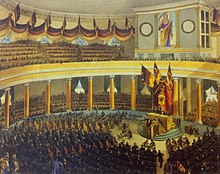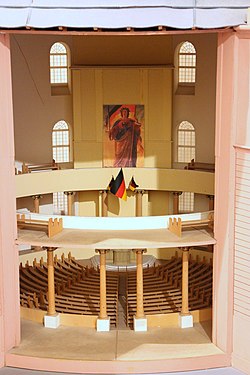Germania (Paulskirche)

Germania is the name of a painting that was probably created in March 1848. It hung in the Paulskirche in Frankfurt . At that time, the so-called pre - parliament met there and then the Frankfurt National Assembly , the first all-German parliament. The National Assembly was a popular motif of the time, so that the Germania painting became very well known. After the National Assembly was forcibly terminated in May 1849, the picture was removed. In 1867 it came to the Germanic National Museum in Nuremberg .
The picture is one of the most famous depictions of Germania , a woman who stands for Germany. Such a national allegory also exists in other countries. The motif was often taken up during the time of the emerging German Empire .
Image content
The early date of completion, at the end of March 1848, could explain the imagery used. At that time there were still few ideas about the future of Germany and its form of government. Accordingly, the painting is politically cautious and refers neither to the popular movement nor to a crown (of a German emperor ). It is significantly less combative than comparable pictures of the revolutionary era, rather conservative-moderating and appealing to the unity of the nation.
“[Germania] stands on a stone pedestal high above a shaded hilly landscape, golden shimmered by the rising sun of a new era. She wears a red, Hermelin-trimmed ruler's robe with the double-headed eagle in the breast shield, and over it a wide, blue-lined gold brocade coat. With her left hand she leans on a medieval tournament lance from which the black, red and gold flag is blowing. The shimmering German tricolor forms the foil for the youthful blonde head of Germania crowned with oak leaves. […] In her right hand Germania holds a raised sword and a hemp flower. A shackle is broken at her feet. "
“With broken shackles, holding the black, red and gold flag in her left hand, she embodies the nation's awakening towards freedom and self-confidence, and in the motif of the bare sword, but with an olive branch, which Germania holds in her right hand , love of peace is combined with a defensiveness that does not yet show the challenging, even belligerent trait of later Germania pictures. "
Originator
Usually one ascribes the picture to Philipp Veit . He had already completed a Germania representation in 1836. This earlier Germania does not stand, but sits and looks melancholy. It is to be seen as a retrospective reference to the Middle Ages , less as a combative symbol for the present. According to Rainer Schoch, according to the type and the allegorical language, the Paulskirchenbild is “obviously” based on Vitus painting from 1836.
Around 1900, various people recorded in their memoirs that the picture from the Paulskirche was made after a drawing by Veit. According to the son of Eduard von Steinle , a painter friend of Veits from the Nazarene circle , his father created the picture for the Paulskirche in a few days. That happened shortly after the election of the Reich Administrator (June 29, 1848).
Friedrich Siegmund Jucho was the “administrator of the estate” of the National Assembly and savior of the constitution . According to him, the picture was "painted by local artists". The pre-parliament already donated it for the Paulskirche. In fact, the picture can already be seen on a lithograph about the pre-parliament (around April 1st). The National Assembly, however, met for the first time on May 18.
Eduard von Steinle and his friends in the Deutsches Haus artist group painted several Germania pictures in 1848. Perhaps the Paulskirchen-Germania is based on a draft by Steinle that is considered lost. Rainer Schoch considers a joint production possible, in which Veit, Steinle and other artists from the German House were involved. Karl Ballenberger , of whom a Germania is also known, may also have belonged to this.
Context of the presentation
The Paulskirche was converted into a parliament hall during the revolution. The lectern of the Presidium replaced the pulpit. A wall behind the lectern was painted with a double-headed eagle , and there were black, red, and gold flags.
The picture of Germania hung over the lectern and thereby covered the organ of the church. It was five meters high and painted on thin cotton fabric. In terms of perspective, it was aimed at a viewer who had taken a seat on the visitors' gallery. On the sides of the picture there were two painted oak wreaths with the following written:
Walk down you sacrificial fire
Over land and sea!
And loop a single love ribbon
For all the peoples!
such as:
The greatness of the fatherland, the happiness of the fatherland
O create it, o bring it back to the people!
The verses were taken from a poem by Georg Herwegh : “The Last War” from 1841. Herwegh was referring to the uprising of the Poles, which was supposed to incite a holy war among the European peoples.
The members of the Paulskirche now saw the painting of Germania at every meeting. On June 28, 1848, they set up a German government, the Provisional Central Authority . On March 28, 1849, they passed an imperial constitution, the so-called Paulskirche constitution .
Whereabouts

After the revolution was suppressed, the Paulskirche was used again for church services. Initially, no institution appeared to be responsible for the inventory of parliament, like the Reich Library . In 1866 the German Confederation was dissolved . The Federal Liquidation Commission handed the painting of Germania and other objects over to the Germanic National Museum in Nuremberg in 1867. The painting was opened again in the museum in September 1870, on the occasion of the victories of the German troops in the Franco-Prussian War .
Copies

Copies of the Germania from the Paulskirche are now in several museums. These include the House of History in Bonn and the memorial for the freedom movements in German history in Rastatt.
Copy in the Rastatt Memorial
literature
- Oliver Mack: Observations during the restoration of Philipp Veit's 'Germania' from the Paulskirche in Frankfurt. On the materiality of a political icon. In: Anzeiger des Germanisches Nationalmuseum. Nuremberg 1999, pp. 291-295.
See also
- Awakening Germania , 1848/1849 by Christian Köhler
- Germania on the watch on the Rhine , 1860 by Lorenz Clasen
Individual evidence
- ^ Online object catalog of the Germanisches Nationalmuseum: Germania , Inv. Gm608.
- ^ Rainer Schoch: Dispute about Germania. Comments on 'Germania' from the Paulskirche . In: Germanisches Nationalmuseum (Ed.): 1848: The Europe of Images. Volume II: Michels March . Nuremberg: Germanisches Nationalmuseum, 1998, pp. 89–102, here pp. 91/92.
- ^ A b Rainer Schoch: Dispute about Germania. Comments on 'Germania' from the Paulskirche . In: Germanisches Nationalmuseum (Ed.): 1848: The Europe of Images. Volume II: Michels March . Nuremberg: Germanisches Nationalmuseum, 1998, p. 89.
- ↑ Dieter Hein: The Revolution of 1848/49 , CH Beck, Munich 1998, p. 73.
- ^ Rainer Schoch: Dispute about Germania. Comments on 'Germania' from the Paulskirche . In: Germanisches Nationalmuseum (Ed.): 1848: The Europe of Images. Volume II: Michels March . Nuremberg: Germanisches Nationalmuseum, 1998, pp. 89–102, here p. 94.
- ↑ Quoted from Rainer Schoch: Streit um Germania. Comments on 'Germania' from the Paulskirche . In: Germanisches Nationalmuseum (Ed.): 1848: The Europe of Images. Volume II: Michels March . Nuremberg: Germanisches Nationalmuseum, 1998, pp. 89–102, here p. 91.
- ^ Rainer Schoch: Dispute about Germania. Comments on 'Germania' from the Paulskirche . In: Germanisches Nationalmuseum (Ed.): 1848: The Europe of Images. Volume II: Michels March . Nuremberg: Germanisches Nationalmuseum, 1998, pp. 89–102, here p. 99.
- ^ Rainer Schoch: Dispute about Germania. Comments on 'Germania' from the Paulskirche . In: Germanisches Nationalmuseum (Ed.): 1848: The Europe of Images. Volume II: Michels March . Nuremberg: Germanisches Nationalmuseum, 1998, pp. 89–102, here p. 89 and p. 92/93.
- ^ Rainer Schoch: Dispute about Germania. Comments on 'Germania' from the Paulskirche . In: Germanisches Nationalmuseum (Ed.): 1848: The Europe of Images. Volume II: Michels March . Nuremberg: Germanisches Nationalmuseum, 1998, pp. 89–102, here p. 100.





